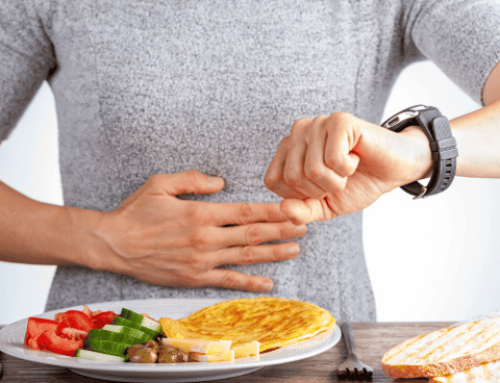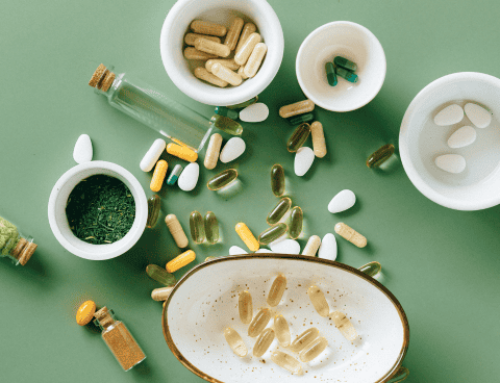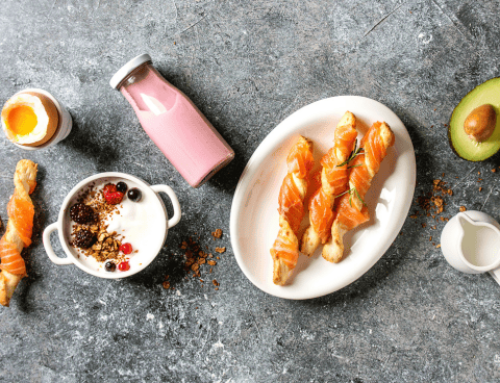You’re Probably Ignoring This Number in the Nutrition Facts—and It Might Be Making You Fat
As a country, America has never been more obese. There’s no one reason for this. Too much added sugar, not enough physical activity, chronic dehydration—all of these things play a role. But as the demand for “healthy” packaged snacks has increased, I’ve noticed another culprit that could be contributing to many people existing in a consistent caloric surplus.
As a refresher, here’s what your average American Nutrition Facts label looks like:
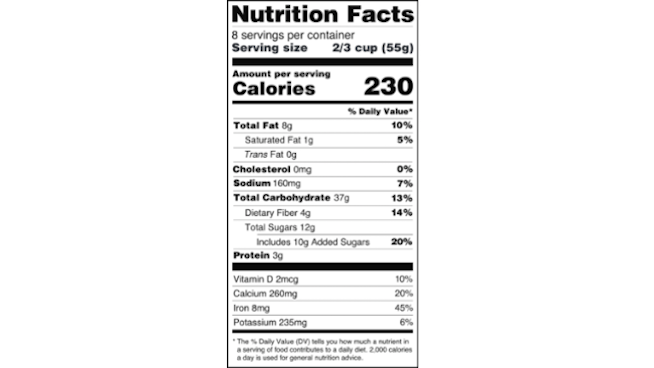
If you’re conscious enough to check the nutrition label, your eyes likely dart to calories, saturated fat, added sugar, and, if you’re really diligent, serving size. But there’s one figure that’s constantly overlooked—weight. Located next to the serving size is usually the weight, in grams, of said serving:
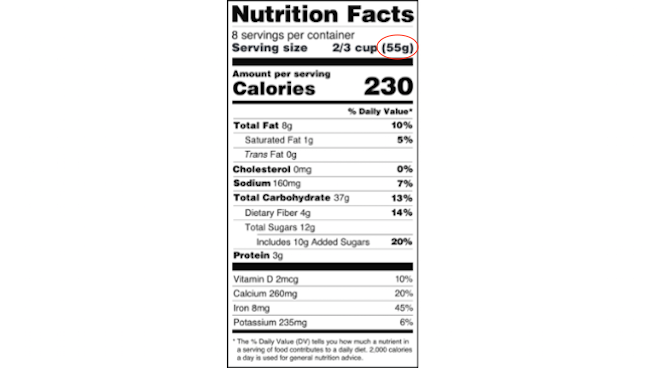
Why does this matter?
When it comes to satiety, the weight of your food matters. Research has found that the average person eats between 3 and 5 pounds of food per day. That’s between 1360 and 2267 grams. In a pamphlet entitled Low-Energy-Dense Foods and Weight Management: Cutting Calories While Controlling Hunger, the CDC writes, “Research shows that people eat a fairly consistent amount of food on a day-to-day basis. This finding holds true whether the amount of food contains many or few calories.”
“That’s the level of food people eat,” says Ryan Andrews, registered dietitian and author of the book Drop The Fat Act & Live Lean. “Whether it’s 3 to 5 pounds of cheese and candy or 3 to 5 pounds of vegetables and fruits. It’s an important factor to feeling satisfied throughout the day.”
Whole foods generally tend to be quite a bit heavier than highly processed ones, largely due to their naturally high water content. To illustrate this, let’s show the weights of some common foods that’ve undergone relatively little processing:
- 1 sweet potato, 130 grams
- 1 avocado, 201 grams
- 1 cup of blackberries, 144 grams
- 1 cup of brown rice, 195 grams
- 1 cup of lentils, 192 grams
- 1 serving of broccoli, 148 grams
And some common foods that’ve undergone high amounts of processing:
- 1 serving of Lay’s Classic Potato Chips, 28 grams
- 1 serving of Ritz Crackers (5 crackers), 16 grams
- 1 serving of Oreo Cookies (3 cookies), 34 grams
- 1 serving of CHEETOS Cruncy Flamin’ Hot Cheese Flavored Snacks, 28 grams
- 1 pouch of Fruit Gushers, 25 grams
- 1 pouch of Cheez-It Original Crackers, 42 grams
See what I’m getting at here? If you could only eat one group or the other to reach 3-5 pounds in a day, you’d have to eat a whole heck of a lot more potato chips, crackers and cookies than you would fruits, veggies and whole grains. Thus, more calories, sodium, added sugar and bad stuff.
You might be saying, “So what? I don’t really eat that junk, anyways.” That’s all well and good, but this problem plagues a lot of the foods that masquerade as healthy snacks—a category that’s absolutely exploded in popularity over the past decade. I’m talking about the chips, crackers, crisps, etc. that are plastered with claims that they’re “Organic” or “Made with Real Veggies!”. They’re pre-packaged and often meant to mimic the qualities you most want in a snack—crunchiness, saltiness, etc.
Products like Popchips, Good Thins, Eatsmart Snacks Veggie Crisps, Shrewd Food Crisps, Garden Veggie Straws, Harvest Snaps, TERRA Real Vegetable Crisps, Annie’s Homegrown Bunny Snacks. At a glance, the nutrition facts look solid. Not many calories. Low fat. Low sugar. Maybe some protein. But again, as healthy as these snacks may seem, they’re often as light as a proverbial feather.
Harvest Snaps are a good example. Pick up a bag, and you’re bombarded by impressive claims of good nutrition. Fresh-picked goodness! 50% less sodium than regular potato chips! 5 grams of plant protein per serving! Our first ingredient is Green Peas! Baked, never fried! Farm direct peas! 50% less fat! The original variety contains just six ingredients, the first of which is green peas. And one serving contains just 130 calories and 0 grams of saturated fat. That’s good, right?
Indeed, one of the few things that tips off a potential red flag is the weight of Harvest Snaps’ serving size. One serving is 22 individual crisps, which sounds like quite a lot. Yet that weighs just 28 grams. One cup of actual green peas weighs 145 grams. You obviously wouldn’t and shouldn’t only eat solely green peas in a day, but if you did, it would take about 9.37 cups to consume 3 pounds. That would equal about 1,105 calories. To consume three pounds of Harvest Snaps Lightly Salted Green Pea Snack Crisps, you’d have to consume more than 48.5 servings—equivalent to 1,068 individual crisps, or 6,305 calories.
How is there such a disconnect between the weight of real green peas and the weight of Harvest Snaps when green peas are their first ingredient? Although Harvest Snaps look like individual green peas that’ve been “crisped,” that’s just a bit of smart product design. In reality, green peas are ground up and then blended with rice and canola oil. Additives are then thrown in the mix to help extend shelf life, then the resulting “crisps” are salted. For flavored varieties, different/additional spices are added during the manufacturing process. While many snacks akin to Harvest Snaps like to trump up their inclusion of healthful ingredients, they almost always undergo a similar process.
Real fruits and veggies are almost entirely water, which gives them considerable weight without containing many calories. Ultra-processed foods, on the other hand, contain almost no water, making them capable of being extremely light yet containing major amounts of calories. The processing methods can also eliminate or negatively alter many beneficial nutrients found in whole veggies. Now, none of this would really matter if you could limit yourself to sensible serving sizes for these snacks. Problem is, that’s almost impossible.
These snacks are the product of cutting-edge food science. The manufacturers are interested in convincing you to buy the product under presumptions of healthiness, but once it’s inside your pantry, they want you to consume it as quickly as possible so you buy more. “Highly processed foods can taste really good. A little too good. This is because they’re designed to elicit maximal levels of pleasure and consumption,” says Andrews.
Interestingly enough, these products also play on a bit of human food psychology—we absolutely adore crunchy, crispy snacks. Simply hearing the words is often enough to conjure up sensations of eating such foods. A recent study in the journal Appetite found that simply labeling a product as “crispy” led participants to eat more of it. Also, having them wear headphones to block the “crunch” sound while eating caused them to eat less of a given food. One reason we overeat such foods is that crunchiness is associated with freshness and quality. Another theory is that “crunchy equals good” is baked into our brains due to our ancestors’ propensity for snacking on hard-bodied insects for nourishment. Crunchiness also seems to override our natural resistance to eating too much of one thing. For example, it’s hard to overeat a bunch of actual sweet potatoes. But sweet potato chips? Heck, it doesn’t seem so tough to polish off a family-sized bag.
If you’re trying to wean yourself off an addiction to classic junk food like Doritos, then these lightweight “healthy” snacks may be of use. But the reality is that their crunchy, salty nature means they’re essentially designed to be overeaten, and most qualities of the healthy ingredients they claim are likely destroyed or degraded during processing. It’s hard to deem foods that don’t actually put a dent in your appetite “healthy.” Next time you pick up a snack that seems too good to be true, consider the weight of the item and whether or not you’d be better served eating the real whole food the product is striving to mimic.
Photo Credit: Kwangmoozaa/iStock
READ MORE:
RECOMMENDED FOR YOU
MOST POPULAR
You’re Probably Ignoring This Number in the Nutrition Facts—and It Might Be Making You Fat
As a country, America has never been more obese. There’s no one reason for this. Too much added sugar, not enough physical activity, chronic dehydration—all of these things play a role. But as the demand for “healthy” packaged snacks has increased, I’ve noticed another culprit that could be contributing to many people existing in a consistent caloric surplus.
As a refresher, here’s what your average American Nutrition Facts label looks like:

If you’re conscious enough to check the nutrition label, your eyes likely dart to calories, saturated fat, added sugar, and, if you’re really diligent, serving size. But there’s one figure that’s constantly overlooked—weight. Located next to the serving size is usually the weight, in grams, of said serving:

Why does this matter?
When it comes to satiety, the weight of your food matters. Research has found that the average person eats between 3 and 5 pounds of food per day. That’s between 1360 and 2267 grams. In a pamphlet entitled Low-Energy-Dense Foods and Weight Management: Cutting Calories While Controlling Hunger, the CDC writes, “Research shows that people eat a fairly consistent amount of food on a day-to-day basis. This finding holds true whether the amount of food contains many or few calories.”
“That’s the level of food people eat,” says Ryan Andrews, registered dietitian and author of the book Drop The Fat Act & Live Lean. “Whether it’s 3 to 5 pounds of cheese and candy or 3 to 5 pounds of vegetables and fruits. It’s an important factor to feeling satisfied throughout the day.”
Whole foods generally tend to be quite a bit heavier than highly processed ones, largely due to their naturally high water content. To illustrate this, let’s show the weights of some common foods that’ve undergone relatively little processing:
- 1 sweet potato, 130 grams
- 1 avocado, 201 grams
- 1 cup of blackberries, 144 grams
- 1 cup of brown rice, 195 grams
- 1 cup of lentils, 192 grams
- 1 serving of broccoli, 148 grams
And some common foods that’ve undergone high amounts of processing:
- 1 serving of Lay’s Classic Potato Chips, 28 grams
- 1 serving of Ritz Crackers (5 crackers), 16 grams
- 1 serving of Oreo Cookies (3 cookies), 34 grams
- 1 serving of CHEETOS Cruncy Flamin’ Hot Cheese Flavored Snacks, 28 grams
- 1 pouch of Fruit Gushers, 25 grams
- 1 pouch of Cheez-It Original Crackers, 42 grams
See what I’m getting at here? If you could only eat one group or the other to reach 3-5 pounds in a day, you’d have to eat a whole heck of a lot more potato chips, crackers and cookies than you would fruits, veggies and whole grains. Thus, more calories, sodium, added sugar and bad stuff.
You might be saying, “So what? I don’t really eat that junk, anyways.” That’s all well and good, but this problem plagues a lot of the foods that masquerade as healthy snacks—a category that’s absolutely exploded in popularity over the past decade. I’m talking about the chips, crackers, crisps, etc. that are plastered with claims that they’re “Organic” or “Made with Real Veggies!”. They’re pre-packaged and often meant to mimic the qualities you most want in a snack—crunchiness, saltiness, etc.
Products like Popchips, Good Thins, Eatsmart Snacks Veggie Crisps, Shrewd Food Crisps, Garden Veggie Straws, Harvest Snaps, TERRA Real Vegetable Crisps, Annie’s Homegrown Bunny Snacks. At a glance, the nutrition facts look solid. Not many calories. Low fat. Low sugar. Maybe some protein. But again, as healthy as these snacks may seem, they’re often as light as a proverbial feather.
Harvest Snaps are a good example. Pick up a bag, and you’re bombarded by impressive claims of good nutrition. Fresh-picked goodness! 50% less sodium than regular potato chips! 5 grams of plant protein per serving! Our first ingredient is Green Peas! Baked, never fried! Farm direct peas! 50% less fat! The original variety contains just six ingredients, the first of which is green peas. And one serving contains just 130 calories and 0 grams of saturated fat. That’s good, right?
Indeed, one of the few things that tips off a potential red flag is the weight of Harvest Snaps’ serving size. One serving is 22 individual crisps, which sounds like quite a lot. Yet that weighs just 28 grams. One cup of actual green peas weighs 145 grams. You obviously wouldn’t and shouldn’t only eat solely green peas in a day, but if you did, it would take about 9.37 cups to consume 3 pounds. That would equal about 1,105 calories. To consume three pounds of Harvest Snaps Lightly Salted Green Pea Snack Crisps, you’d have to consume more than 48.5 servings—equivalent to 1,068 individual crisps, or 6,305 calories.
How is there such a disconnect between the weight of real green peas and the weight of Harvest Snaps when green peas are their first ingredient? Although Harvest Snaps look like individual green peas that’ve been “crisped,” that’s just a bit of smart product design. In reality, green peas are ground up and then blended with rice and canola oil. Additives are then thrown in the mix to help extend shelf life, then the resulting “crisps” are salted. For flavored varieties, different/additional spices are added during the manufacturing process. While many snacks akin to Harvest Snaps like to trump up their inclusion of healthful ingredients, they almost always undergo a similar process.
Real fruits and veggies are almost entirely water, which gives them considerable weight without containing many calories. Ultra-processed foods, on the other hand, contain almost no water, making them capable of being extremely light yet containing major amounts of calories. The processing methods can also eliminate or negatively alter many beneficial nutrients found in whole veggies. Now, none of this would really matter if you could limit yourself to sensible serving sizes for these snacks. Problem is, that’s almost impossible.
These snacks are the product of cutting-edge food science. The manufacturers are interested in convincing you to buy the product under presumptions of healthiness, but once it’s inside your pantry, they want you to consume it as quickly as possible so you buy more. “Highly processed foods can taste really good. A little too good. This is because they’re designed to elicit maximal levels of pleasure and consumption,” says Andrews.
Interestingly enough, these products also play on a bit of human food psychology—we absolutely adore crunchy, crispy snacks. Simply hearing the words is often enough to conjure up sensations of eating such foods. A recent study in the journal Appetite found that simply labeling a product as “crispy” led participants to eat more of it. Also, having them wear headphones to block the “crunch” sound while eating caused them to eat less of a given food. One reason we overeat such foods is that crunchiness is associated with freshness and quality. Another theory is that “crunchy equals good” is baked into our brains due to our ancestors’ propensity for snacking on hard-bodied insects for nourishment. Crunchiness also seems to override our natural resistance to eating too much of one thing. For example, it’s hard to overeat a bunch of actual sweet potatoes. But sweet potato chips? Heck, it doesn’t seem so tough to polish off a family-sized bag.
If you’re trying to wean yourself off an addiction to classic junk food like Doritos, then these lightweight “healthy” snacks may be of use. But the reality is that their crunchy, salty nature means they’re essentially designed to be overeaten, and most qualities of the healthy ingredients they claim are likely destroyed or degraded during processing. It’s hard to deem foods that don’t actually put a dent in your appetite “healthy.” Next time you pick up a snack that seems too good to be true, consider the weight of the item and whether or not you’d be better served eating the real whole food the product is striving to mimic.
Photo Credit: Kwangmoozaa/iStock
READ MORE:

